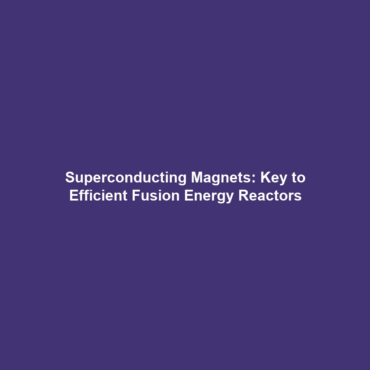Superconducting Magnets: Key to Advancing Fusion Energy
Introduction
Superconducting magnets are at the forefront of fusion energy technology, playing a vital role in tokamaks by confining plasma efficiently. Their ability to generate powerful magnetic fields allows for stable plasma containment, which is essential for nuclear fusion reactions. As the world seeks sustainable and clean energy sources, advancements in superconducting magnet technology become increasingly significant, directly impacting reactor efficiency and the feasibility of fusion as a practical energy source.
Key Concepts
Understanding Superconducting Magnets
Superconducting magnets operate based on the principles of superconductivity, a phenomenon where certain materials exhibit zero electrical resistance at low temperatures. This allows superconducting magnets to carry immense currents without energy loss, making them ideal for use in fusion reactors. The most common superconducting materials used in tokamaks include niobium-titanium and niobium-tin, which enable the generation of high magnetic fields needed for effective plasma confinement.
The Role in Fusion Energy
In the context of fusion energy, superconducting magnets are crucial for stabilizing the plasma, which can reach temperatures exceeding millions of degrees. By maintaining this extreme environment, fusion reactions that can potentially provide a near-limitless source of clean energy can occur.
Applications and Real-World Uses
The applications of superconducting magnets in fusion energy are substantial:
- Used in advanced tokamaks such as ITER, where they enable sustained plasma confinement.
- Utilized in research facilities around the globe to explore nuclear fusion as a clean energy source.
- Contribute to improving the performance of fusion reactors by enhancing efficiency and stability.
These applications highlight how superconducting magnets are transforming the future of fusion energy.
Current Challenges
Challenges of Superconducting Magnets in Fusion Energy
While superconducting magnets hold immense promise, several challenges persist:
- Material Limitations: Developing materials that can withstand the extreme conditions within a fusion reactor remains a challenge.
- Cost: The expense involved in producing and maintaining superconducting magnets can hinder their widespread adoption.
- Cooling Requirements: Superconducting magnets require extensive refrigeration systems to maintain low operating temperatures, complicating reactor design.
Future Research and Innovations
Ongoing research into improving superconducting materials aims to overcome these challenges. Innovations may include:
- New high-temperature superconductors that can function under less extreme cooling conditions.
- Advancements in magnet design that optimize performance while reducing costs.
- Emerging technologies like DEMO (Demonstration Power Plant) that seek to utilize these magnets for practical fusion energy generation.
These developments will be pivotal in determining the future landscape of fusion energy.
Conclusion
In summary, superconducting magnets are essential for the advancement of fusion energy, significantly impacting plasma confinement and reactor efficiency. With ongoing research and innovations, the potential of fusion as a clean energy source is moving closer to becoming a reality. To learn more about the transformative potential of fusion energy, visit our fusion energy resource page.

